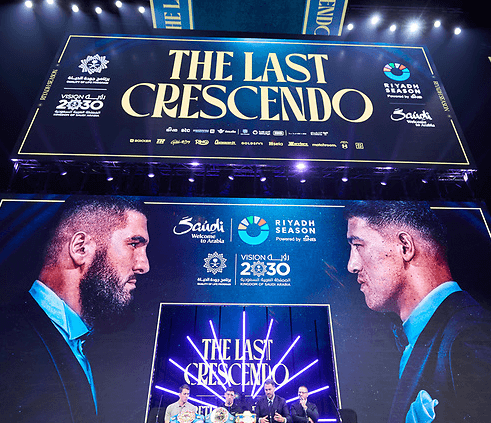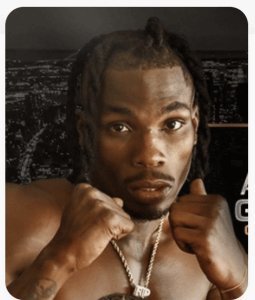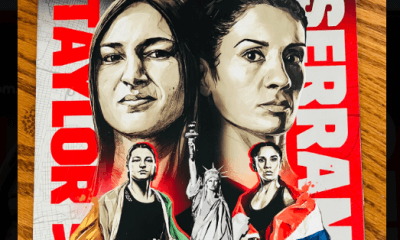Featured Articles
The Hauser Report — Riyadh Season and Sony Hall: Very Big and Very Small

Larry Goldberg promoted his eleventh club fight card at Sony Hall in New York on February 20, continuing the Boxing Insider series that began in October 2022.
Goldberg is well thought of in boxing circles. Matchmaker Eric Bottjer notes, “Here are some words that I have not heard in connection with Larry: ‘Scam artist . . . Liar . . . Untrustworthy.’ He has a good reputation. That doesn’t equate to success on its own. But it’s good when you’re sitting down with people who might want to work with you.”
That said; the life of a small promoter is hard. Goldberg’s February 20 show is a case in point.
Six fights had been scheduled. But last-minute, chaos reigned. The New York State Athletic Commission refused to clear one fighter because of a troubling MRI. Another fighter pulled out because his father thought that his B-side opponent (who had a (6-17-3 record with 6 KOs by) was “the wrong style.” Then the mother of a third fighter tried to hold Goldberg up for an increase in her son’s purse from $1,200 to $2,000 and the fight disappeared when Larry balked at her demand.
That left three fights. And guess what? It was a surprisingly entertaining card. The fights were more competitive that most club fights. And all six fighters came to win.
Jason Castanon (1-1, 1 KO) vs. Stephen Barbee (0-2, 1 KO by) was the first bout of the evening. Neither man was particularly skilled. But they fought hard and both men had a chance to win. Castanon emerged on the long end of a 39-37, 39-37, 38-38 majority decision.
Koby Khalil Williams (4-0, 3 KOs) vs. Nicholas Isaac (5-0, 4 KOs) was next up.
Williams’s four wins had come against opponents who now have a total of 4 wins in 48 fights. Isaac’s record had been fashioned against opponents who are 9-and-49 with 24 KOs by. The bout was a significant step up for both men. The result was a spirited, six-round action fight with Isaac prevailing on all three judges’ scorecards.
Finally, Avious Griffin (16-0, 15 KOs) squared off against Jose Luis Sanchez (14-4-1, 4 KOs, 1 KO by). Griffin has built his record by fighting opponents with limited skills. Sanchez fit that profile. Both men threw non-stop punches. But Griffin’s were faster, straighter, more accurate, and harder. Sanchez was dropped three times in the early rounds (by a left hook, an overhand right, and a right uppercut). In round five, Griffin appeared to tire a bit. And Sanchez was still there. At that point, the fight devolved into an “I’ll punch you and then you punch me” affair, and it seemed possible that Avious would crumble. But he didn’t. Jose Luis had a lot of heart. He just wasn’t good enough. Griffin regrouped and ended matters on an eight-round stoppage with Sanchez still on his feet.

Avious Griffin
Watching the fights, my mind went back to a conversation I had with Ray Arcel when I began writing about boxing four decades ago.
Arcel (a Hall of Fame legend who trained scores of world champions during his years in the sweet science) told me, “Too many people don’t take pride in what they do. They do just enough to get by, maybe to hold onto their jobs, and that’s all. A fighter can’t be like that.” And Arcel went on to reminisce about a time when four-round preliminary fighters on their way to the gym would look back over their shoulder and see kids following them on the street, offering to carry their gym bag. A fighter would come home and neighborhood children would be sitting on the stoop, looking at him and saying, “Wow, he’s a fighter.”
There used to be glory at the club fight level. Being a good club fighter was an end in itself. Now, for the most part, club fights are regarded as stepping stones for prospects who face off against woefully overmatched opponents. On February 20, Larry Goldberg gave boxing fans three good club fights.
****
Two nights later, on February 22, the latest Riyadh Season fight card took place in Saudi Arabia. Seven fights of note were on the card, leading the promotion to proclaim that it was “the greatest fight card in the history of boxing.”
It wasn’t. And that was true even before Daniel Dubois and Floyd Schofield pulled out of scheduled title fights due to illness.
You don’t put “the greatest fight card ever” in a 6,000-seat arena (Venue Riyadh Season) when the 25,000-seat Kingdom Arena is next door. Moreover, fight cards are judged in large measure by the main event. And the main event here wasn’t a megafight on the order of Leonard-Hearns I or a half-dozen Muhammad Ali encounters.
That said; it was an exceptionally good card. Credit to Turki Alalshikh for putting it together. Thumbnail sketches of the fights that mattered most (in the order that they occurred) follow.
Callum Smith broke Joshua Buatsi down with a brutal body attack in the middle rounds. Both fighters were hurt as the fight went on. But Buatsi was hurt more and more often. It was a very good fight with Smith prevailing on a 119-110 (which was way out of line), 116-112, 115-113 decision.
Zhilel Zhang vs. Agit Kabayel was an entertaining slugfest with both men evincing a conspicuous lack of upper-body and head movement. After a cautious first round, Kabayel attacked. Zhang, who is 41 years old and has never been in particularly good shape, started fading in round three. Kabayel got sloppy in round four and was dropped by a straight left hand. But Agit went back on the offensive and stopped Zhang with body shots in the fifth stanza.
Vergil Ortiz Jr. vs. Israil Madrimov was a fight that boxing purists were looking forward to. Ortiz is a puncher and wanted to engage. Madrimov didn’t. Israil kept skittering around the ring and Virgil couldn’t figure him out. Then the Energizer Bunny wore down and there were some heated exchanges. That was the fight Virgil (who began scoring big to the body) wanted. Ortiz won a 117-111, 115-113, 115-113 decision.
Carlos Adames vs. Hamzah Sheeraz for Adames’s WBC 160-pound belt had particular significance. Sheeraz (a 5-to-2 betting favorite) is a favorite of Turki Alalshikh who had big plans for him. The belief was that Hamzah would beat Carlos and continue to increase his profile. Meanwhile, Canelo Alvarez’s four-fight deal with Riyadh Season will begin with fights against William Scull and Terence Crawford this year. Then, the thinking went, Canelo would fight the winner of Chris Eubank Jr vs. Conor Benn on Cinco de Mayo Weekend 2026 followed by a fight against Sheeraz on next year’s Mexican Independence Day Weekend.
Adames-Sheeraz was a step-up fight for Sherraz. And he fell short of expectations.
After a cautious first round, Adames began stalking. He couldn’t get past Sheeraz’s jab. Hamzah dictated the distance between them with his jab and footwork. But Sheeraz seemed intimidated and threw few punches of consequence. It was a slow fight. Carlos didn’t silence the crowd. But Hamzah did. The judges ruled the fight a split-decision draw, which meant that Adames retained his title.
Shakur Stevenson vs. Josh Padley was not a good fight. Floyd Scholfield (an 8-to-1 underdog) fell out as Stevenson’s opponent for medical reasons during fight week. Padley, a 30-to-1 underdog. took his place. The typical Shakur Stevenson opponent is slow without much of a punch. Padley is slow without much of a punch. Prior to being called in as a late replacement earlier in the week, he had been on the job installing solar panels. Shakur stopped him in the ninth round.
Then the heavyweights returned to center stage – Joseph Parker vs. Martin Bakole. Parker had been slated to challenge Daniel Dubois for Dubois’ alphabet-soup “championship” belt. But two days before the fight, Dubois pulled out after contracting a viral infection.
Large amounts of money can do wondrous things. When Larry Goldberg lost three fighters during fight week, he was left with a three-bout card. When Dubois was scratched, Turki Alalshikh simply opened his checkbook and brought in Bakole.
Martin was in Africa when he got the call and arrived in Riyadh at 2:00 AM on the day of the fight. Most of us have trouble keeping our eyes open after a trans-continental fight. Bakole had to fight Parker. Moreover, Martin weighed in at a massive 315 pounds, which clearly indicated that he wasn’t in shape (unless one considers round a shape).
Round one saw Parker biding his time while Bakole plodded slowly forward. Two minutes into the second stanza, Joseph landed a glancing right hand off the top of Martin’s head. Bakole went down. He got up. And his corner stopped the fight.
That wasn’t what fans were hoping for. But then they were treated to an exceptionally good fight.
Artur Beterbiev was an 11-to-10 favorite over Dmitry Bivol in a rematch of their October 2024 title-unification bout which Beterbiev won on a close majority-decision. This time, as before, the momentum swung back and forth. But this fight was more intensely contested than their first encounter.
Beterbiev came out hard. He couldn’t reach Bivol, who was circling away and outjabbing him. But Artur was relentless. He started landing and, by the middle rounds, was outpunching and outboxing Dmitry. Then Beterbiev (who at age forty is six years older than Bivol) tired a bit and Dmitry regained control of the contest. Both men were in good condition. Fighting desperately at the end, Artur finished stronger. But this time, the majority decision was in Bivol’s favor.
“What was different?” Dmitry was asked after the fight.
“Just me,” BivoI answered. “I was better.”
****
And a note from the past . . .
In 2004, Tom Gerbasi (who was writing for Maxboxing.com at the time) went to the PAL Gym in Upper Darby, Pennsylvania, to record a video interview with Bernard Hopkins while Bernard was training to fight Oscar De La Hoya.
“Hopkins wanted to do the interview while he was getting his hands wrapped,” Gerbasi recalls. “But there was a problem. My camera guy wasn’t there. Hopkins is telling me, ‘Look! I gotta do this now because I have to get my workout in.’ So I interviewed him for twenty minutes while Bouie Fisher was wrapping his hands without my camera guy there. Then Hopkins sparred and went through the rest of his workout. He’s done for the day and getting ready to leave the gym. And finally, my camera guy shows up. He’s very apologetic. He tells us he’s late because he was pulled over by the police and handcuffed because of a bunch of unpaid traffic tickets, which I assume were moving violations. Bernard says, ‘Show me your wrists.’ So my guy shows Bernard his wrists. There were marks from the handcuffs all over them. And Bernard tells us, ‘Okay. Set up the camera.” I did the interview all over again and wound up writing a four-part piece, ten thousand words.”
Thomas Hauser’s email address is thomashauserwriter@gmail.com. His most recent book – MY MOTHER and me – is a personal memoir available at Amazon.com. https://www.amazon.com/My-Mother-Me-Thomas-Hauser/dp/1955836191/ref=sr_1_1?crid=5C0TEN4M9ZAH&keywords=thomas+hauser&qid=1707662513&sprefix=thomas+hauser%2Caps%2C80&sr=8-1
In 2004, the Boxing Writers Association of America honored Hauser with the Nat Fleischer Award for career excellence in boxing journalism. In 2019, Hauser was selected for boxing’s highest honor – induction into the International Boxing Hall of Fame.
To comment on this story in the Fight Forum CLICK HERE
-

 Featured Articles4 weeks ago
Featured Articles4 weeks agoAvila Perspective, Chap. 330: Matchroom in New York plus the Latest on Canelo-Crawford
-

 Featured Articles3 weeks ago
Featured Articles3 weeks agoVito Mielnicki Jr Whitewashes Kamil Gardzielik Before the Home Folks in Newark
-

 Featured Articles21 hours ago
Featured Articles21 hours agoResults and Recaps from New York Where Taylor Edged Serrano Once Again
-

 Featured Articles4 weeks ago
Featured Articles4 weeks agoCatching Up with Clay Moyle Who Talks About His Massive Collection of Boxing Books
-

 Featured Articles5 days ago
Featured Articles5 days agoFrom a Sympathetic Figure to a Pariah: The Travails of Julio Cesar Chavez Jr
-

 Featured Articles3 weeks ago
Featured Articles3 weeks agoMore Medals for Hawaii’s Patricio Family at the USA Boxing Summer Festival
-

 Featured Articles1 week ago
Featured Articles1 week agoCatterall vs Eubank Ends Prematurely; Catterall Wins a Technical Decision
-

 Featured Articles4 weeks ago
Featured Articles4 weeks agoRichardson Hitchins Batters and Stops George Kambosos at Madison Square Garden




















